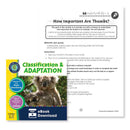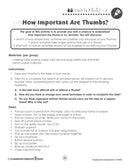Description
**THIS IS AN INSTANT DOWNLOAD**
This FREE worksheet includes 1 page from our Classification & Adaptation title.
This Hands-On Experiment worksheet asks students to determine the importance of thumbs. This worksheet can be used on their own, or paired with the individual resource. And the best part is, it's FREE.
************************************************************************
About the full resource, Classification & Adaptation:
Delve deep into ecosystems by classifying the beings that live there. Our resource breaks down the different kinds of animals before studying their different adaptations. Start off by answering the question: what do we classify? Then, break down this classification into kingdom, phylum, class, family, genus, and finally species. Compare the differences between warm-blooded and cold-blooded animals. Create a brochure on your favorite vertebrate before inventing your own invertebrate. Introduce the concept of adaptation and how animals have changed based on their environment. Take this further by conducting a case study on the adaptations of the koala. Finally, explore the concept of evolution and how this idea is backed up by fossil records. Aligned to the Next Generation Science Standards and written to Bloom's Taxonomy and STEAM initiatives, additional hands-on experiments, crossword, word search, comprehension quiz and answer key are also included.
This FREE worksheet includes 1 page from our Classification & Adaptation title.
This Hands-On Experiment worksheet asks students to determine the importance of thumbs. This worksheet can be used on their own, or paired with the individual resource. And the best part is, it's FREE.
************************************************************************
About the full resource, Classification & Adaptation:
Delve deep into ecosystems by classifying the beings that live there. Our resource breaks down the different kinds of animals before studying their different adaptations. Start off by answering the question: what do we classify? Then, break down this classification into kingdom, phylum, class, family, genus, and finally species. Compare the differences between warm-blooded and cold-blooded animals. Create a brochure on your favorite vertebrate before inventing your own invertebrate. Introduce the concept of adaptation and how animals have changed based on their environment. Take this further by conducting a case study on the adaptations of the koala. Finally, explore the concept of evolution and how this idea is backed up by fossil records. Aligned to the Next Generation Science Standards and written to Bloom's Taxonomy and STEAM initiatives, additional hands-on experiments, crossword, word search, comprehension quiz and answer key are also included.






